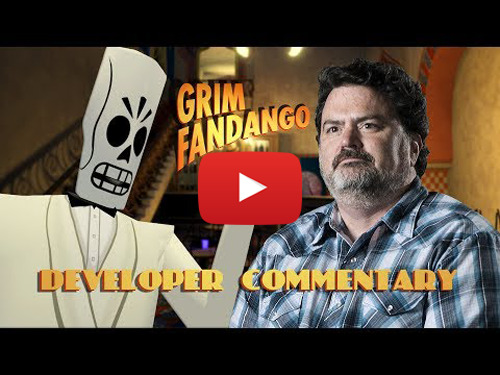Grim Fandango Remastered – Double Fine – 2015
One of my most significant direct contributions to a video game was my work on the developer commentary for Grim Fandango Remastered. I joined the project as a newly promoted assistant producer in summer 2014 and had to take on many roles that were new to me. In the case of the commentary, I had to help plan the recording sessions in which members of the development team talked for about four hours per group. One interesting limitation was that we needed to limit the recording sessions to four hours but a game playthrough is much longer, so some of the commentary was recorded only from watching the first half of the game. I sat through all the sessions and jotted down notes to remember the timecodes for particularly engaging commentary.
I had to take on the responsibility for the commentary audio as well since our audio team was stretched thin working on this game and Broken Age, both games that have a ton of dialogue. I had to pore over those sixteen or so hours and pick out the most interesting commentary to include in the game. That required listening to the complete tracks and marking the segments to extract with the Audacity audio editing app. Thankfully, Audacity includes a feature which allows highlighting segments with a text comment and then exporting those segments with the comment as the filename. I had to consider the commentary that should appear in certain locations and those anecdotes that were more generalized and could be placed anywhere in the game. I was also mindful of the length of each segment, since I felt that players don’t want to be stuck in a room for too long as they wait for commentary to play. It was an unfortunate limitation of the game that commentary could only within the room it is triggered. The final commentary in the game is a bit over two hours and fifteen minutes, but I believe my original extracts added up to more than three hours.
Once extracted, I had to design the commentary’s placement by selecting the places in the game where the player could look at an object or enter a room to receive a prompt that indicated they could press a button to play the commentary. This design document was for the programmers on the team who would have to hook up the triggers and the audio that should play when that trigger is hit. I didn’t have much context for this type of design except for the commentary from Portal, so I modeled my choices on my memories of Portal’s implementation. As for the commentary that would play, I was mindful of various factors. I wanted to make sure commentary was about the room or situation in which the player was currently located as much as possible, but I peppered in the more general anecdotes in some places, especially the latter half of the game which wasn’t viewed and commented on by some of the guests who came in to record. I also wanted to make sure that I balanced out the commentary as much as possible to include everyone and make sure the player heard different bits of commentary from the range of personalities and roles of the participants.
So eventually I had a defined list of audio clips representing all of the commentary that would play in the game and the programmers had the audio clips working in the game. Initially, I didn’t think we would need subtitles for these commentary clips, but I was convinced by Mark Cooke from Shiny Shoe (co-developer of all three of Double Fine’s remastered LucasArts games) that we should have subtitles, and that missing subtitles would be a huge omission and a let-down for the fans. I came around on the idea and agreed to take on the role of transcriber as well. I used a transcription app that opens a audio clip and allows the user to type out the commentary as they listen. It was months of work to transcribed it all myself. The final step was to also fill out a JSON file or something similar that outlined when each audio clip began and ended, which was required for determining when the subtitles should appear and disappear on the screen. It was well worth the effort to make sure that the subtitles were there for players who need or prefer that option in their games.
We began work on the game in summer 2014 and finished the base game by December, with a release in late January 2015 and several updates and ports to other platforms afterward. This was all in addition to my other duties both as assistant producer on this project and for Broken Age, which was due to release in spring 2015. This formative experience always stands out to me both for the first time I had my hands so directly on a game’s content, but also for the opportunity and trust I received from the team and in particular the executive producer, Matt Hansen, to take on the responsibility and make decisions that would directly impact the gameplay experience. This is how Double Fine operated as a matter of course, but it was an empowering and daunting first project on which to flex those underutilized muscles.
